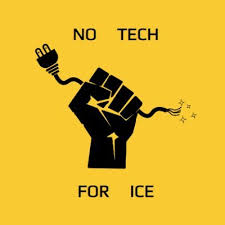- About
- Topics
- Picks
- Audio
- Story
- In-Depth
- Opinion
- News
- Donate
- Signup for our newsletterOur Editors' Best Picks.Send
Read, Debate: Engage.
| June 19, 2018 | |
|---|---|
| topic: | Digital Rights |
| tags: | #facial recognition, #biometric ID, #MoMA |
| located: | USA |
| by: | Sofia Gallarate |
The unique make-up, also known as Computer Vision Dazzle (CV Dazzle), has been firstly developed by artist Adam Harvey on the basis that facial-recognition algorithms identify the person by recognising key facial features based on symmetry and skin tones. By breaking the facial lineaments with strokes of make-up applied to the cheekbones, chin, and forehead, it is possible to confuse the computer, thus avoiding being unwillingly profiled for marketing or security purposes.
Since biometric technology has been linked with the camera, many of our daily activities, such as passing through security gates and entering offices have forever changed. And it is just a matter of time before most of our daily activities will be facilitated by the technology: from buying groceries, unlocking our iPhones and entering private buildings, most of the actions we perform will be activated through the scanning of our facial features—much like fingerprint technology took over the smartphone security systems. Arguably, facial-recognition technology will be the next fundamental step in how we interact with the world around us as it’s set to lessen the gap between human and technology even further—transforming accessibility.
Personal activities aside, facial-recognition technology is also being used by governmental and military bodies to run surveillance programmes. The risk is that—once it falls into the wrong hands—such technology could be used to target people participating in political meetings or protests, or more broadly to assert control over the freedom of speech and agency of citizens. The possibility that this technology could be used for profiling and targeting people because of oppositional beliefs isn’t out of the question altogether, and with it, isn’t it fundamental to develop counteractive tools that could be used for resistance?
In a time when facial-recognition technology is paving its way into our lives at a speed both users and lawmakers are not able to keep up with, acts of resistance such as the application of anti-surveillance make-up is a creative and significant attempt to tackle the privacy issues that society is currently only beginning to understand. The power of facial-recognition technology is only starting to reveal its mechanisms to us, and between blockbuster headlines such as the sexual-orientation detection algorithms developed at Stanford University and Cambridge Analytica, it’s clear we have no idea what’s ahead of us.
Although presented within an artistic and playful environment, the reasoning behind this anti-surveillance camouflage speaks of the public’s concerns towards their own privacy as well as liberty. With a decorative touch to the face, artists and creatives are coming up with radical ways to counteract a service that has all the ingredients to be used for a noxious concoction.
This article was first published in
By copying the embed code below, you agree to adhere to our republishing guidelines.
